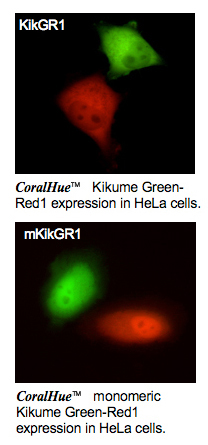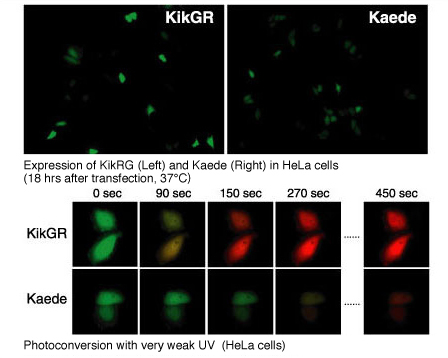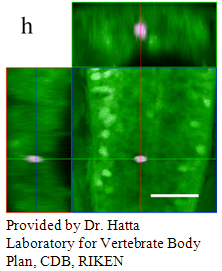Kikume Green-Red
Brighter photoconvertible fluorescent protein with high sensitivity
 Photoconvertible fluorescent protein
Photoconvertible fluorescent protein- Monomer / tetramer
The fluorescent protein Kikume Green gene was isolated from the stony coral Favia favus (Kikume-ishi in Japanese).
CoralHue™ Kikume Green-Red1 (KikGR1) protein emits bright green fluorescence that can be irreversibly converted to red. KikGR1 can be photoconverted by irradiation with UV or violet light (350-410 nm). Photoconverted KikGR1 possesses excitation/emission maxima at 583/593 nm. KikGR1 contains a His62-Tyr63-Gly64 tripeptide sequence which forms a green chromophore that can be photoconverted to a red one via formal beta-elimination and subsequent extension of the π-conjugated system. CoralHue™ monomeric Kikume Green-Red (mKikGR1) maintains the brightness of the parent protein KikGR1. mKikGR1 can be used for labeling proteins or subcellular structures.

Images are provided by Dr.Tsutsui Hidekazu and Dr. Miyawaki Atsushi,
Laboratory for Cell Function and Dynamics,
BSI, RIKEN
KikGR1

mKikGR1

| Kikume Green-Red(KikGR) spectrum data files (text files) | |
|---|---|
| mKikume Green excitation ( |
mKikume Green emission ( |
| mKikume Red excitation ( |
mKikume Red emission ( |
| Kikume Green excitation ( |
Kikume Green emission ( |
| Kikume Red excitation ( |
Kikume Red emission ( |
Note: The file is in a tab-delimited text format. It contains values of the wavelength (1nm spacing) and brightness (fluorescence intensity peak value normalized to 1). Use a spreadsheet program to create a spectrum that will help you in choosing the appropriate excitation filter, dichroic mirror and fluorescence filter.
| CHARACTERISTIC | KikGR1 | mKikGR1 | ||
|---|---|---|---|---|
| photoconverted | photoconverted | |||
| Oligomerization | Tetramer | Tetramer | Monomer | Monomer |
| Number of amino acid | 225 | 225 | 233 | 233 |
| Excit./Emiss. maxima (nm) | 507/517 | 583/593 | 505/517 | 580/591 |
| Molar extinction coefficient (M-1cm-1) | 53,700 (507 nm) | 35,100 (583 nm) | 47,100 (504 nm) | 21,750 (579 nm) |
| Fluorescence quantum yield | 0.70 | 0.65 | 0.53 | 0.64 |
| Brightness*1 | 37.6 | 22.8 | 25.0 | 13.9 |
| pH sensitivity | pKa=7.8 | pKa=5.5 | pKa=6.5 | pKa=5.2 |
| Cytotoxicity*2 | No | No | No | No |
*1Brightness: Molar Extinction Coefficient ×Fluorescence Quantum Yield / 1000
*2Toxicity when expressed in HeLa cells
KikGR1 transgenic zebrafish
 The KikGR1 transgenic zebrafish was observed using two-photon excitation microscopy. KikGR1 can be photoconverted using two-photon excitation microscopy with the laser tuned to 780 nm.
The KikGR1 transgenic zebrafish was observed using two-photon excitation microscopy. KikGR1 can be photoconverted using two-photon excitation microscopy with the laser tuned to 780 nm.
Cell tracking using a photoconvertible fluorescent protein.
Hatta K, Tsujii H, Omura T.
Nat Protoc. (2006) 1: 960-967.
Recommended antibodies
CoralHue™ Kikume Green-Red can be recognized using antibodies as shown below.
- Anti-Kikume Green-Red for WB, Code No. M128-3M
WB: Western blotting, IP: Immunoprecipitation
References
- Tsutsui H, Karasawa S, Shimizu H, Nukina N, Miyawaki A. Semi-rational engineering of a coral fluorescent protein into an efficient highlighter. EMBO Rep. (2005) 6: 233-238 . PMID: 15731765
- Hatta K, Tsujii H, Omura T. Cell tracking using a photoconvertible fluorescent protein. Nat Protoc. (2006) : 960-967. PMID: 17406330
- Habuchi S, Tsutsui H, Kochaniak AB, Miyawaki A, van Oijen AM. van Oijen mKikGR, a Monomeric Photoswitchable Fluorescent Protein. PLoS ONE (2008) 3: e3944 PMID: 19079591
- Tsutsui H, Shimizu H, Mizuno H, Nukina N, Furuta T, Miyawaki A. The E1 mechanism in photo-induced beta-elimination reactions for green-to-red conversion of fluorescent proteins. Chem Biol. (2009) 16:1140-7. PMID: 19942137
- Mizuno H, Dedecker P, Ando R, Fukano T, Hofkens J, Miyawaki A Higher resolution in localization microscopy by slower switching of a photochromic protein. Photochem Photobiol Sci. (2010) 2: 239-248. PMID: 20126801
※CoralHue™ Kikume Green-Red is the product licensed to MBL affiliates, for patent application JP 2005-507027 and/or foreign equivalents owned by the Institute of Physical and Chemical Research (RIKEN)
※CoralHue™ fluorescent proteins were co-developed with the Laboratory for Cell Function and Dynamics, the Advanced Technology Development Center, the Brain Science Institute, RIKEN. MBL possesses the license and deals in the products.
Please send us a completed and signed License Acknowledgement.
Please note that the product will be shipped after we receive a
completed and signed License Acknowledgement (PDF file on the right).
Prior to shipping, our staff may contact you to verify the intended use
of the product. Please also note that a separate agreement or a contract
may be required depending on the intended use.
The product you have ordered is sold for research purpose only. It is
not intended for industrial or clinical use, and shall not be used for
any purposes other than research. You are also asked not to hand over or
resell the product to a third party.
If you belong to a profit organization or a business corporation, or
wish to use the product for profit or commercial purposes, please
contact us.

- Fluorescent protein
- Basic fluorescent proteins
- Midoriishi-Cyan [Outline] [Product list]
- Umikinoko-Green [Outline] [Product list]
- Azami-Green [Outline] [Product list]
- Kusabira-Orange [Outline] [Product list]
- dKeima570 [Outline] [Product list]
- Keima-Red [Outline] [Detection of mitophagy with Keima-Red] [Product list]
- Photoconvertible fluorescent proteins
- Dronpa-Green [Outline] [Product list]
- Kaede [Outline] [Product list]
- Kikume Green-Red [Outline] [Product list]
- Organelle targeting vectors [Product list]
- Advanced fluorescent indicators
- Image based Protein-Protein interaction analysis "Fluoppi" [Outline] [Fluoppi Red] [Product list]
- Cell cycle indicator "Fucci" [Outline] [Product list]
- Protein-Protein Interaction Detection System "CoralHue™ Fluo-chase Kit" [Outline] [Product list]
- Anti-CoralHue™ fluorescent protein antibodies
- Anti-CoralHue™ fluorescent protein antibodies [Outline] [Product list]
- Resources
- CoralHue™ vectors full DNA sequence
- Spectrum



